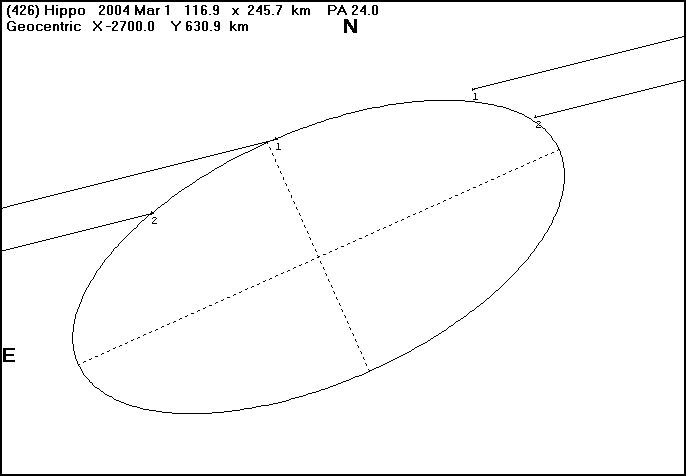Total observed chords: 2
Two chords were observed across this planet by Ian Bacon and Ralph Paramor in or near Perth, WA. Conditions were not ideal with very strong twilight.
Observers: 1 Bacon 2 Paramor

(Plot generated using WinOCCULT)
Event Analysis:
The predicted duration of this event was 5.3 seconds. Both observers experienced difficulty owing to the onset of twilight and generally poor sky conditions, with Ian noting that his times were only accurate to 1-2 sec and Ralph noting that his duration was suspiciously long. As such therefore, the data cannot be used to provide any definitive result. The best that can be stated is that the observations confirm the accuracy of the updated path.
That said however, an ellipse fitted to the observations is presented below although considerable caution should be exercised in ite examination since it is unlikely to be a true representation of the shape of the asteroid. Only one additional observation from the Perth area might have been sufficient to suitably refine the above reports.
There are no previous occultation reports for minor planet Hippo.
Observational Data:
Observer's Name : Ian Bacon
Aperture (cm) : 25
Focal length (cm) : 250
Type (e.g. SCT; Newtonian) : SCT
Magnification :
Observing site name : Perth, W.A.
Longitude (East +ve) : 115 degrees 49 minutes 57.7 seconds east
Latitude (South -ve) : 31 degrees 50 minutes 21.9 seconds east
Height above Sealevel (metres) : 40
Sky Transparency : Poor
Star Image Stability : Fair
Other Conditions:
(Wind, Clouds, Lights, etc.): lgt cloud/haze
TIMINGS:
Time Source (e.g. WWV, VNG) : Telstra
Recording method (e.g. tape) : computer
Could you see the Asteroid? : No
Approx. Limiting Magnitude : 10.5
| Estimated |
Universal Time | Reaction | Accuracy, Remarks
h m s | Time (sec) |
Started Observing : 21 12
Disappearance At : 21 15 13 see below
Reappearance At : 21 15 17
Stopped Observing : 21 12
Duration : 4 sec
Was your reaction time (also known as Personal Equation) subtracted from
any of the above timings? : NO
ADDITIONAL COMMENTS:
This was a marginal observation. There was light haze in the sky and the Sun was only 10 degrees below
the horizon. Because of these conditions the star was just visible with averted vision. However,
having said this, the star definitely disappeared for several seconds. But, I cannot be certain of the
exact duration, nor the precise disappear and reappear times. The times given above are only accuarate to
1 - 2 seconds.
Observer's Name : Ralph Paramor
Aperture (cm) : 20
Focal length (cm) : 200
Type (e.g. SCT; Newtonian) : SCT
Magnification : 80
Observing site name : COTTESLOE
Longitude (East +ve) : +115d 45m 14s
Latitude (South -ve) : -32d 00m 18s
Height above Sealevel (metres) : 30
Sky Transparency : Poor
Star Image Stability : Fair
Other Conditions:
(Wind, Clouds, Lights, etc.): Close to dawn
TIMINGS:
Time Source (e.g. WWV, VNG) : GPS checked against telephone
Recording method (e.g. tape) : tape
Could you see the Asteroid? : NO
Approx. Limiting Magnitude : 11
| Estimated |
Universal Time | Reaction | Accuracy, Remarks
h m s | Time (sec) |
COLUMN FORMAT TO USE---> __:__:__._ _._ _________________)
Started Observing : 21 14 00
Disappearance At : 21 15 10.4
Reappearance At : 21 15 18.2
Stopped Observing : 21 15 30
Duration : 7.8 sec
Was your reaction time (also known as Personal Equation) subtracted from
any of the above timings? : NO
ADDITIONAL COMMENTS:
Observation was well after onset of astronomical twilight (sun about 10 degrees below horizon).
That and light pollution associated with cities (albeit early in the morning) made for difficult
viewing conditions. Am unable to explain the suspiciously long period of occultation.
[Top of Page][Return to Home Page]